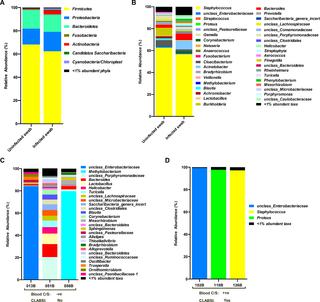Our official English website, www.x-mol.net, welcomes your
feedback! (Note: you will need to create a separate account there.)
Microbiome signatures in neonatal central line associated bloodstream infections.
PLOS ONE ( IF 2.9 ) Pub Date : 2020-01-16 , DOI: 10.1371/journal.pone.0227967 Mohan Pammi 1 , Santosh Thapa 2, 3 , Miriam Balderas 2, 3 , Jessica K Runge 2, 3 , Alamelu Venkatachalam 2, 3 , Ruth Ann Luna 2, 3
PLOS ONE ( IF 2.9 ) Pub Date : 2020-01-16 , DOI: 10.1371/journal.pone.0227967 Mohan Pammi 1 , Santosh Thapa 2, 3 , Miriam Balderas 2, 3 , Jessica K Runge 2, 3 , Alamelu Venkatachalam 2, 3 , Ruth Ann Luna 2, 3
Affiliation

|
Neonates are at high risk for central line associated bloodstream infections (CLABSI). Biofilm formation is universal on indwelling catheters but why some biofilms seed the bloodstream to cause CLABSI is not clearly understood. With the objective to test the hypothesis that catheter biofilm microbiome in neonates with CLABSI differs than those without infection, we prospectively enrolled neonates (n = 30) with infected and uninfected indwelling central catheters. Catheters were collected at the time of removal, along with blood samples and skin swabs at the catheter insertion sites. Microbiomes of catheter biofilms, skin swabs and blood were evaluated by profiling the V4 region of the bacterial 16S rRNA gene using Illumina MiSeq sequencing platform. The microbial DNA load was higher from catheter biofilms of CLABSI patients without differences in alpha diversity when compared to that of the non-CLABSI neonates. Proteus and unclassified Staphylococcaceae were more abundant in infected catheter biofilms while Bradyrhizobium, Cloacibacterium, and Sphingomonas were more abundant in the uninfected catheters. A blood microbiome was detected in uninfected samples. The blood microbiome in CLABSI neonates clustered separately from the uninfected blood samples in beta diversity plots. We found that the microbiome signature in catheter biofilm and blood of neonates with CLABSI is different than the microbiomes of non-CLABSI neonates.
中文翻译:

新生儿中心线相关的血液感染中的微生物组特征。
新生儿患中线相关血流感染(CLABSI)的风险很高。生物膜的形成在留置导管上普遍存在,但是为什么某些生物膜会播种血流以引起CLABSI尚不清楚。为了检验假设,即带有CLABSI的新生儿与未感染的新生儿相比,导管生物膜微生物组有所不同,我们前瞻性地招募了被感染和未感染的留置中心导管的新生儿(n = 30)。取出时收集导管,并在导管插入部位收集血液样本和皮肤拭子。通过使用Illumina MiSeq测序平台对细菌16S rRNA基因的V4区进行分析,评估了导管生物膜,拭子和血液的微生物组。与非CLABSI新生儿相比,CLABSI患者导管生物膜的微生物DNA负荷较高,而α多样性无差异。变形杆菌和未分类的葡萄球菌在受感染的导管生物膜中含量较高,而缓生根瘤菌,支气管杆菌和鞘氨醇在未感染的导管中含量较高。在未感染的样本中检测到血液微生物组。β多样性图中,CLABSI新生儿的血液微生物组与未感染的血液样品分开聚集。我们发现,CLABSI新生儿的导管生物膜和血液中的微生物组特征与非CLABSI新生儿的微生物组不同。变形杆菌和未分类的葡萄球菌在受感染的导管生物膜中含量较高,而缓生根瘤菌,支气管杆菌和鞘氨醇在未感染的导管中含量较高。在未感染的样本中检测到血液微生物组。β多样性图中,CLABSI新生儿的血液微生物组与未感染的血液样品分开聚集。我们发现,CLABSI新生儿的导管生物膜和血液中的微生物组特征与非CLABSI新生儿的微生物组不同。变形杆菌和未分类的葡萄球菌在受感染的导管生物膜中含量较高,而缓生根瘤菌,支气管杆菌和鞘氨醇在未感染的导管中含量较高。在未感染的样本中检测到血液微生物组。β多样性图中,CLABSI新生儿的血液微生物组与未感染的血液样品分开聚集。我们发现,CLABSI新生儿的导管生物膜和血液中的微生物组特征与非CLABSI新生儿的微生物组不同。
更新日期:2020-01-17
中文翻译:

新生儿中心线相关的血液感染中的微生物组特征。
新生儿患中线相关血流感染(CLABSI)的风险很高。生物膜的形成在留置导管上普遍存在,但是为什么某些生物膜会播种血流以引起CLABSI尚不清楚。为了检验假设,即带有CLABSI的新生儿与未感染的新生儿相比,导管生物膜微生物组有所不同,我们前瞻性地招募了被感染和未感染的留置中心导管的新生儿(n = 30)。取出时收集导管,并在导管插入部位收集血液样本和皮肤拭子。通过使用Illumina MiSeq测序平台对细菌16S rRNA基因的V4区进行分析,评估了导管生物膜,拭子和血液的微生物组。与非CLABSI新生儿相比,CLABSI患者导管生物膜的微生物DNA负荷较高,而α多样性无差异。变形杆菌和未分类的葡萄球菌在受感染的导管生物膜中含量较高,而缓生根瘤菌,支气管杆菌和鞘氨醇在未感染的导管中含量较高。在未感染的样本中检测到血液微生物组。β多样性图中,CLABSI新生儿的血液微生物组与未感染的血液样品分开聚集。我们发现,CLABSI新生儿的导管生物膜和血液中的微生物组特征与非CLABSI新生儿的微生物组不同。变形杆菌和未分类的葡萄球菌在受感染的导管生物膜中含量较高,而缓生根瘤菌,支气管杆菌和鞘氨醇在未感染的导管中含量较高。在未感染的样本中检测到血液微生物组。β多样性图中,CLABSI新生儿的血液微生物组与未感染的血液样品分开聚集。我们发现,CLABSI新生儿的导管生物膜和血液中的微生物组特征与非CLABSI新生儿的微生物组不同。变形杆菌和未分类的葡萄球菌在受感染的导管生物膜中含量较高,而缓生根瘤菌,支气管杆菌和鞘氨醇在未感染的导管中含量较高。在未感染的样本中检测到血液微生物组。β多样性图中,CLABSI新生儿的血液微生物组与未感染的血液样品分开聚集。我们发现,CLABSI新生儿的导管生物膜和血液中的微生物组特征与非CLABSI新生儿的微生物组不同。











































 京公网安备 11010802027423号
京公网安备 11010802027423号